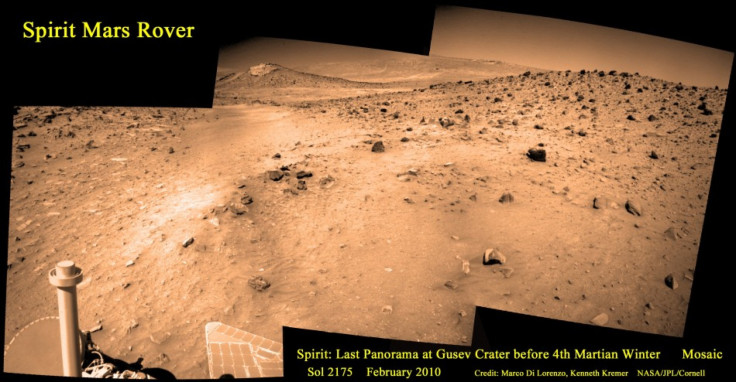A Look at Mars: Last photo from NASA's rover Spirit

NASA recently released the last image the rover Spirit captured on its mission to Mars, revealing a rocky, hilly landscape and a world that at one time likely had hot springs, a thick atmosphere, and a water cycle.
The rover, which reached Mars in January 2004 for a baseline mission of 90 days, continued to relay data to Earth for seven years. It had a robotic arm that aided it in examining soil and a drill bit that abraded rocks to assess their composition.
On NASA's website, the agency says it considers the Spirit mission a huge success and cites three major discoveries the rover made:
Evidence of ancient hot springs. Two years into the mission, the right front wheel stopped working--we're still not sure why, said project manager John Callas. Spirit had to drag it along, cutting a furrow in the ground. This revealed deposits of amorphous silica widely thought to have formed in hydro-thermal systems. Apparently, Mars once had water and the energy to warm it. We might never have found this if not for the serendipity of the broken wheel.
Evidence of a thick atmosphere and sweet water. Mars could have sustained life billions of years ago. The carbonates Spirit found formed in surface water that could only exist with a thick atmosphere sitting on top of it to prevent rapid evaporation, said Callas. Moreover, the chemistry of the carbonates tells us that the water wasn't acidic like other ancient water on Mars.
Evidence of an active water cycle. Spirit churned up the soil when it hit a sand pit, revealing sulfates that suggest the presence of water recently--in geological terms, that is. These minerals appear to have come in contact with water perhaps as recently as a million years ago, said Callas.
The rover became mired in a sand pit in April 2009, preventing NASA from situating it with its solar panels directly facing the sun during the harsh Martian winter, as the agency had done in previous years. Scientists believe the internal components of Spirit were damaged by the extreme cold (in excess of 67 degrees below zero Faranheit) after its survival heating ran out of power. NASA gave up on Spirit at the end of March after losing contact with the rover for more than a year. This photo was taken in February 2010.
The prominent hill in the top middle of the panorama, with the white top, is dubbed Von Braun and was the next destination for Spirit before its wheels got stuck in the sand. Another NASA rover sent to Mars in 2004, Opportunity, is currently exploring the other side of Mars.





















